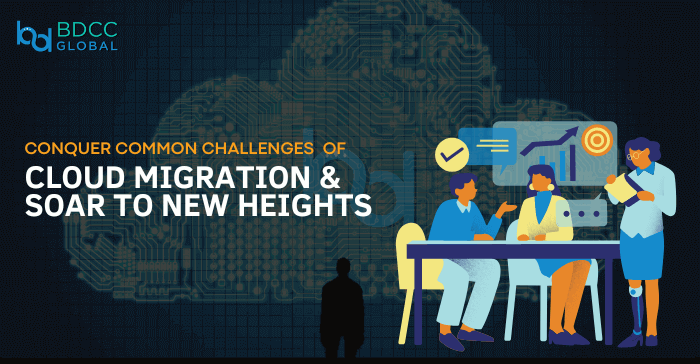
Is cloud migration giving you sleepless nights? Fear not! Explore the common hurdles and discover the secret formula to overcome them easily.
You’re standing at the edge of a vast cloud landscape, ready to embark on a transformative journey. But you need help with data security concerns, application compatibility issues, and performance bottlenecks.
Looking to migrate to the cloud? Learn about the challenges and practical solutions in this blog post to ensure a smooth transition.
Common Challenges Faced During Cloud Migration
Security and Compliance Concerns
Data security and compliance are paramount considerations when migrating to the cloud. Organizations must protect their sensitive data throughout migration and in the cloud environment. Implementing strong security measures, such as encryption, regular audits, and access limits, is necessary to achieve this.
Additionally, it is necessary to manage industry-specific requirements like GDPR and HIPAA compliance. Collaborating with cloud migration service providers that offer robust security features and compliance certifications can help organizations address these concerns effectively.
Change Management
Migration to the cloud requires an organization’s IT infrastructure and business processes to change considerably. Employees may need help adapting to the new environment. Effective change management practices should be followed to communicate the advantages of cloud migration, include employees in the decision-making process, and provide training and assistance to facilitate a smooth transition.
Clear communication, ongoing education, and fostering a culture of innovation and collaboration can help overcome resistance and ensure the successful adoption of cloud technologies.
Lack of Proper Planning and Strategy
A key challenge in cloud migration is a comprehensive plan and strategy. Many businesses must address the challenge of moving infrastructure, data, and applications to the cloud. Investing sufficient time and resources in developing a well-defined migration plan is crucial to overcome this challenge.
This plan should include a detailed evaluation of the current systems, a list of dependencies, and a phased migration strategy. Organizations may reduce risks and guarantee a seamless move to the cloud by establishing a defined process.
Compatibility and Integration Issues
Another challenge while implementing a cloud migration strategy is the compatibility and integration of existing systems with cloud platforms. Many legacy applications may need to be designed to run in a cloud environment, leading to compatibility issues. To overcome this, organizations should thoroughly assess their applications and identify any necessary modifications or re-architecting for a successful migration.
Leveraging cloud-native technologies and employing integration tools can facilitate seamless integration between on-premises and cloud systems.
Performance and Scalability Considerations
Achieving optimal performance and scalability in the cloud is a crucial objective for organizations. However, poor planning and configuration can lead to scalability constraints and performance bottlenecks.
Organizations should carefully analyze their workload requirements to address these cloud migration challenges and select appropriate cloud service models (IaaS, PaaS, or SaaS) that align with their needs. Implementing load balancing, auto-scaling, and performance monitoring mechanisms can help optimize performance and ensure scalability in the cloud environment.
Training and Skill Gaps
Migration to the cloud requires expertise in cloud technologies and methodologies. Many organizations need more skilled professionals to manage and operate cloud environments effectively.
To bridge this skill gap, organizations should invest in training programs to upskill their existing IT workforce or hire experienced cloud professionals. Collaborating with cloud service providers that offer comprehensive training and certification programs can also be beneficial in building the necessary expertise.
Cost Optimization
While cloud migration consulting offers potential cost savings, optimizing costs to maximize the benefits is essential. If cloud services are not managed effectively, they may become pricey. Organizations should implement cost optimization strategies such as rightsizing instances, monitoring resource utilization, leveraging reserved or spot instances, and implementing automation for resource provisioning and de-provisioning.
Organizations may achieve cost efficiency and ensure they only pay for the necessary resources by regularly reviewing and optimizing their costs.
Vendor Lock-In
Vendor lock-in is when a company becomes overly reliant on one cloud service provider, making it difficult to move to a different one or bring services back in-house. Organizations should carefully evaluate and compare cloud service providers to avoid vendor lock-in based on pricing, service offerings, performance, scalability, and data portability.
Adopting a multi-cloud or hybrid cloud approach is also recommended, where services are distributed across multiple providers or a combination of on-premises and cloud environments. This approach provides flexibility and mitigates the risks associated with vendor lock-in.
Performance Monitoring and Optimization
Once the cloud data migration is complete, ongoing performance monitoring and optimization are essential to ensure optimal functionality and cost-effectiveness of the cloud infrastructure. Monitoring tools should be implemented to track performance metrics, identify bottlenecks, and proactively address issues.
Continuous optimization measures, such as rightsizing resources, optimizing database configurations, and implementing caching mechanisms, can help improve performance and user experience while controlling costs.
Disaster Recovery and Business Continuity
Cloud migration should include a robust disaster recovery (DR) and business continuity plan. Data loss, system failures, or natural disasters can occur. Therefore, organizations must have mechanisms to recover and ensure business continuity quickly.
Cloud providers offer DR options, such as data replication across multiple regions, automated backups, and failover mechanisms. Organizations should assess their recovery point objectives (RPO) and recovery time objectives (RTO) to determine the appropriate DR strategy and implement regular testing to validate the plan’s effectiveness.
Outcome
Numerous advantages of moving to the cloud include cost savings, scalability, and enhanced agility. However, dealing with the typical difficulties throughout the relocation process is vital. By implementing proper planning, addressing security concerns, ensuring compatibility and integration, optimizing performance, and investing in training, organizations can overcome these challenges and unlock the full potential of cloud migration.
BDCC
Latest posts by BDCC (see all)
- Four Steps to Balance Agility and Security in DevSecOps - April 22, 2025
- Enhancing Security Posture with Azure’s AI-Driven Threat Detection - April 15, 2025
- Why Golang is Becoming the Go-To Language for DevOps Engineers - April 11, 2025

